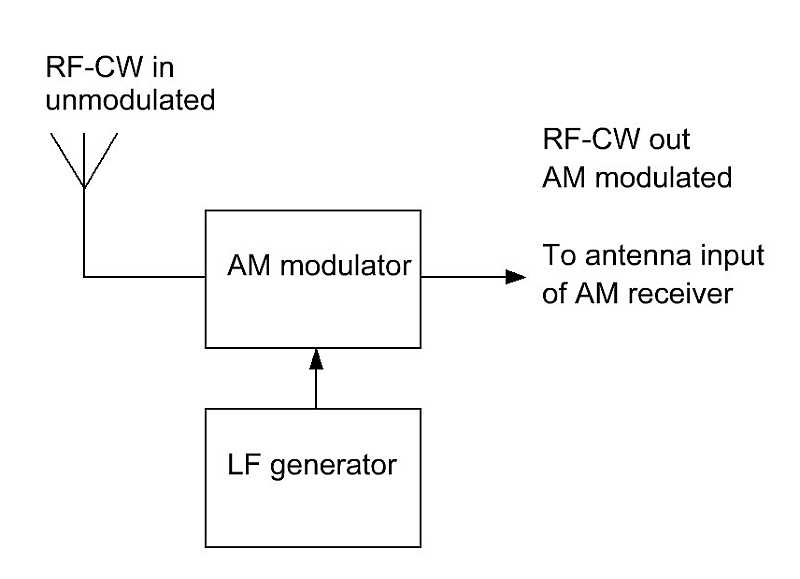CW RECEPTION WITH AN AM RECEIVER
(1980)
KLIK HIER VOOR DE NEDERLANDSE VERSIE
CW reception with a Beat Frequency Oscillator
Usually, CW is transmitted as an unmodulated carrier. To make it audible, a BFO (Beat Frequency Oscillator) is used. The frequency of the BFO is a few hundred hertz lower or higher than the frequency of the CW signal. In a detector, a beat tone is generated. That is an audio tone with a tone height equal to the difference of the frequencies of the CW signal and the BFO oscillator. This works excellent, sensitivity is very good and all CW signals can be seperated very good as they have different tone heights, as long as their transmit frequencies are different. A disadvantage is that you can receive only a limited frequency range, namely within an audible bandwidth around the BFO frequency. And if the frequency of your receiver is drifting a little, the audio tone changes too.

In 1980, I wanted to receive CW signals with this AM receiver.
How is that possible without a Beat Frequency Oscillator (BFO)?
Reception of a CW signal with an AM receiver
When we want to receive CW with an AM receiver, then the RF signal has to be amplitude modulated with a tone. Such an amplitude modulated signal can be received with an AM detector (for example a diode detector or crystal detector).

Amplitude modulation in the receiver instead of the transmitter!
Amplitude modulation in the receiver instead of the transmitter!
I had a very nice AM receiver with a 500 kHz loopantenna. And I wanted to receive the coastal stations transmitting morse code with that receiver. But then the CW signals had to be amplitude modulated with a tone. Then I had the idea to realize the amplitude modulation not in the transmitter but in the receiver. A simple amplitude modulation was placed between the loopantenna and the AM receiver and... it worked! The unmodulated CW carriers were amplitude modulated with a tone before they were presented to the antenna input of the receiver! And the amplitude modulated CW signals were perfectly audible with the AM receiver! Did the frequency of the (not so stable) AM receiver drift a few kilo Hertz, no problem, the audio tone remained the same because there is no beat tone used. Not only that single signal that you receive is modulated with a tone, but al signals!

The diagram of the simple amplitude modulator between antenna and AM receiver input.
Of course it is possible to realize such an amplitude modulator in many other (and better) ways.
New idea?
When I made and tried this circuit in 1980, I thought it was quite a nice idea. But was it really such a new, unique idea? Not so long ago I saw a PDF version of an ARRL handbook from 1936. And in that book, the same idea was described. The unmodulated CW signals were amplitude modulated with a tone in the first tube of the intermediate frequency amplifier. The grid was connected to a low frequency oscillator. By means of the variation in the gain of the tube in the rhythm of the low frequency signal, the CW signal became amplitude modulated. So it was already a very old idea...
Other applications
Of course the disadvantage is that you do not have any audio selectivity, all CW signals do have the same tone height. The sensitivity of such a receiver is also not so good. But there are other applications for this decoding principle or making unmodulated signals audible with an AM receiver.
You can use this principle for a wide band AM receiver. You can make for example a monitor receiver that receives the whole CW part of a certain amateur band. When there are conditions, you do hear all CW signals on the whole band (with the same tone height...).
Or you can make a monitor receiver for your CW signals: A whip antenna, the amplitude modulator and a wide band diode receiver (1 - 30 MHz) with audio amplifier. You can use this receiver as side tone and level indicator. When the tone becomes louder, then the signal is stronger.
Or you can make a very sensitivie RF detector. As the signals are amplitude modulated, you can use a simple AC amplifier after the diode detector instead of a difficult to make and temperature drifting DC amplifier. Or even your sound card of the PC!
Remarks
It is very important to design the circuit so that the signal of the LF generator does not disturb the other circuits after the detector, or radiates into the audio part of the receiver.
And in the ARRL handbook from 1936 it is adviced to apply this amplitude modulation also in a normal CW receiver with BFO. With extra amplitude modulation, the CW signals do sound much better and that makes listening to CW signals less tiring!

It is a nice idea and it works! But even a simple
"Barefoot Technology" regenerative receiver is better!
Index PA2OHH




